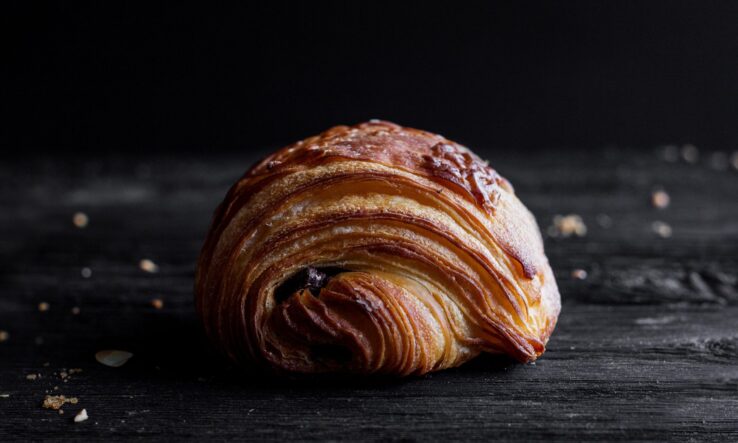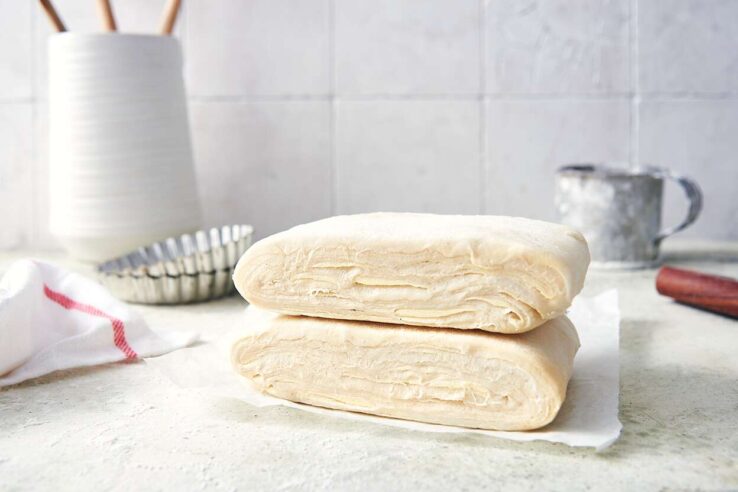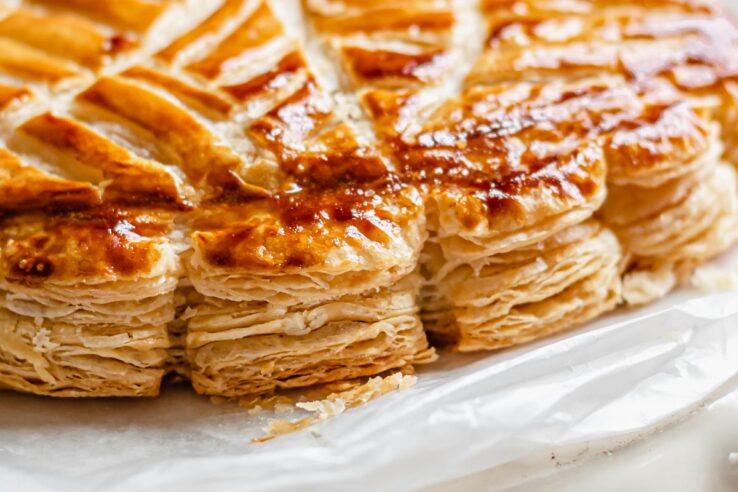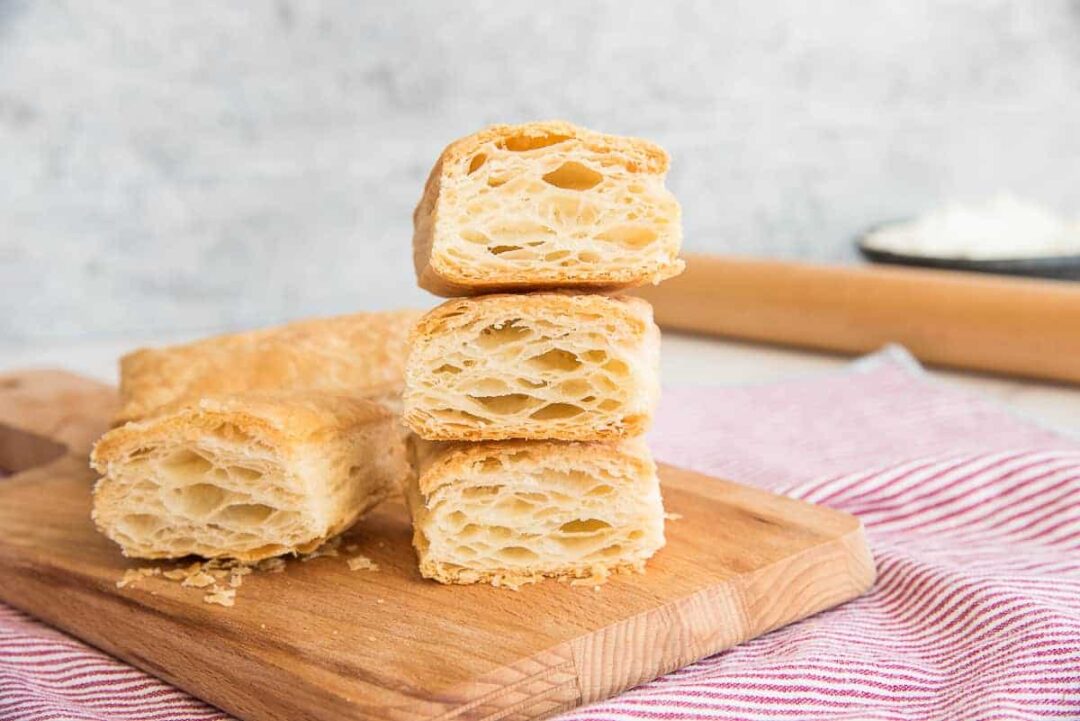Puff pastry is one of the most versatile and beloved pastries in baking. Its light, airy texture and flaky layers make it perfect for sweet and savory dishes. But baking this can be a daunting task. It requires proper handling and preparation to achieve the perfect rise and texture.
What is a puff pastry?
It’s a laminated dough that consists of alternating layers of butter and dough. When it is baked, the butter melts, creating steam. This separates the layers and causes it to puff up.
The process of creating these layers is called lamination. The folding process creates multiple layers of butter and dough, which results in the pastry’s flaky texture when baked.
Best Practices for Baking Puff Pastry

Source: freepik.com
These practices are essential to achieving a perfectly flaky and light dessert.
Prepare the Pastry
The first step in preparing this tasty dessert is to thaw it properly. Place the frozen pastry in the refrigerator overnight for half an hour before using it. Avoid thawing at room temperature. This will cause the dough to become too soft and difficult to work with.
When ready to bake, lightly dust your work surface with flour and gently roll the pastry to your desired thickness. Avoid overworking the dough, as this can cause the layers to stick together and prevent the it from rising properly. When you do this, you’ll notice that your puff pastry will lose its flakiness.
Use the Proper Baking Sheet
Using a suitable baking sheet is essential to achieving a perfect flaky dough. A light-colored aluminum sheet is ideal, as it distributes heat evenly and prevents the it from over-browning. You can also use a heavy, sturdy sheet with low sides. This baking sheet prevents the edges from burning.
Avoid using dark or non-stick baking sheets since they’re notorious for causing it to burn.
Remember also to use the appropriate size of the baking sheet. If it’s too large, the dough may not have enough support to hold its shape during baking, causing it to collapse or spread out too much. Use a calculator to convert the imperial system to an SI unit, for example, 3/8 inch to mm. This allows you to get accurate measurements.
Apply Egg Wash and Toppings
Egg wash combines beaten eggs and water brushed on the dough before baking. This mixture helps to create a shiny and golden-brown crust.
For a sweeter flavor, sprinkle sugar on the egg wash before baking. For a savory one, sprinkle grated cheese or herbs.
Monitor and Adjust Temperature
Puff pastry can be delicate, so monitor the baking process closely. Preheat the oven to 400°F. Bake the it for about 25 minutes or until golden brown and puffed up.
Check your pastry periodically to ensure it is baking evenly. If one side is browning faster than the other, rotate the baking sheet to ensure even baking. If the dough is browning too quickly, lower the oven temperature to 375°F (190°C).
Pro Tips for Perfect Flaky Dough

Source: youtube.com
Let’s dive into some pro tips for baking the perfect puff pastry.
Keep Ingredients and Tools Cold
Keeping the ingredients and tools cold is essential for a light and flaky puff pastry. Cold butter and dough create steam when they come in contact with the oven’s heat. This contact causes it to puff up. Chill the butter and dough before starting the lamination process, and work quickly to prevent them from getting too warm.
If the butter layers melt, your pastry will not rise correctly, resulting in a heavy and greasy texture. It is best to work in a cool environment, and you can even chill your rolling pin and cutter before use.
Use a Sharp Knife
Using a sharp knife is essential to achieving a clean and even cut. A dull knife can crush the layers and prevent the dough from rising properly. This is especially important when making intricate designs or cutting out shapes.
Create Steam in the Oven
Creating steam in the oven when baking puff pastry is crucial to achieving the it’s signature flaky and delicate texture. When you place it in a hot oven, the water in the dough and butter layers evaporates, creating steam. The steam expands the layers of the dessert, causing them to puff up and separate from each other.
However, note that steam results from a hot and humid oven. Preheat the oven thoroughly before baking puff pastry. You should maintain a humid environment inside the oven throughout the baking process.
You can spray the inside of the oven with water before placing the dessert inside. This can be done using a spray bottle. Do this quickly and carefully to avoid lowering the temperature of the oven or getting water on the pastry.
Alternatively, you can place a hot water tray in the oven’s bottom while the dessert bakes. The steam from the hot water will rise and fill the oven. This will create a humid environment to help the pastry puff up and expand properly.
Regardless of the method used, monitor the pastry carefully while it bakes. Too much steam can cause it to become soggy or limp.
Troubleshoot Common Issues
Even the most experienced bakers can run into issues from time to time.
If your puff pastry doesn’t rise evenly or if certain parts are puffier than others, there is likely a problem with the layers. Uneven layers can be caused by not rolling out evenly or by not folding it correctly during the lamination process. To avoid this issue, roll out the dough to an even thickness, and fold and roll it evenly at each turn.
This delectable dessert can quickly burn if the oven is too hot or if it is left in for too long. To avoid burning, carefully monitor it while baking. You can also cover it with foil halfway through baking to prevent it from getting too dark.
Key Takeaways

Source: facebook.com
Baking perfect puff pastry requires proper handling, preparation, and execution. Understanding the science behind the lamination process is crucial to achieving the desired texture and rise.
Bake perfect puff pastry every time with these tips:
- Prepare the pastry and use the appropriate baking sheet
- Apply egg wash and monitor the temperature
- Use proper ingredients and tools
- Know how to create steam and deal with common baking issues




